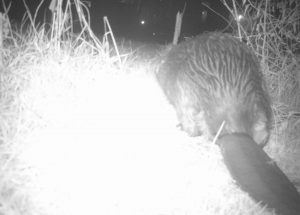GREENEVILLE – With an arboretum, a wetland, a 300-year-old tree and great-horned owls, Tusculum University is blessed with an outdoor science laboratory that provides students with plenty to study and observe during their years at the higher education institution.

The Natural Sciences Department has collected this photo of a beaver from a video camera stationed on the bank of College Creek.
Another item on the list: beavers.
In recent months, at least one beaver has made a home in College Creek, which runs on the edge of the Greeneville campus adjacent to the Paul E. Hayden Educational Wetland. Professors in the Natural Sciences Department have collected a nighttime photo of a beaver from a video camera stationed on the creek bank and have seen evidence of the animal’s activity, including slides and a couple of dams.
“It’s nice and academically beneficial to have even more wildlife and diversity on campus,” said Jordan Baker, an assistant professor of biology. “For us as biologists and environmental scientists, we’re happy because it shows that people can see an assortment of animals and other organisms on campus without having to head to the mountains or other remote areas during a time when group travel is not advised. That is attractive for students who want to study in that kind of environment.”

Dr. Heather Henson-Ramsey and Jordan Baker show how trees planted in spring 2020 are thriving.
Baker said the beaver’s arrival might be the result of work the College of Science, Technology and Math conducted at the creek in spring 2020. Using a grant from the Tennessee Wildlife Resources Agency, the college planted a total of about 400 trees and shrubs on the bank of College Creek.
That project had a multifaceted purpose – cleaner water, protection of the bank from erosion and maintenance of the creek’s integrity. Decreasing erosion can reduce sediment buildup in the creek and prevent harm to aquatic life and altered water flow.
Since the completion of that work, the newly planted trees are thriving, and grasses along the bank grew several feet high, exactly the types of results the Natural Sciences Department hoped to see.
Baker said the presence of one or more beavers is further indication the effort to improve the riparian zone is working.
“That riparian zone provides a habitat for more biological diversity, not only large mammals but small ones as well,” Baker said. “It created a more natural habitat, with increased bank stability, and beavers gravitate toward that type of environment. It gives them access to more food and creates the atmosphere for them to establish residence.”
The age and exact dimensions of the beaver or beavers are unknown, but Baker described the one in the photo as “good-sized.” He said the university plans to install a new camera to receive higher-quality photos of the beaver.
The only potential drawback to a beaver’s presence and activity is flooding of the creek. The Natural Sciences Department has seen no sign of that, but if that were to develop, the university would alert the appropriate authorities so they could relocate however many beavers are present.
Tusculum has previously had beavers on campus, and it is unclear if they left or were removed.
Dr. Heather Henson-Ramsey, dean of the College of Science, Technology and Math, said the abundant biological diversity on the campus is ideal for students and faculty.
“One element we emphasize in the university’s mission statement is providing an active and experiential education for our students,” Dr. Henson-Ramsey said. “The discovery of one or more beavers in College Creek adds to the variety of animals on our campus. When you combine that with all of the other natural beauty that Tusculum has, our students have the opportunity for a multifaceted scientific experience. That is extremely exciting, and we will continue to be good stewards of our campus environment.”
For more information about the university, please visit www.tusculum.edu.


